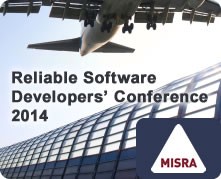
Technology event organiser Energi Technical has announced that it will be launching "The Reliable Software Developers' Conference", scheduled for May 2014.
This one-day conference will provide an important forum for engineers and developers working in the development of safety critical systems and high availability systems. It is expected to attract software developers working in such industries as automotive, railway systems, aerospace, banking, medical and energy. www.rsd-conference.co.uk
"In recent years, software has become so complex that ensuring safety and reliability is now a major challenge," said Richard Blackburn, Event Organiser. "Many systems now have millions of lines of code and will handle enormous amounts of data. Further to this, modern computer based systems will make millions of decisions every second and also have to be immune to interference and unpredictable events. This event will look at the MISRA coding standards, debug tools and software testing tools that are available to assist software programmers and engineers seeking to develop reliable and safety critical
systems."
systems."
The Reliable Software Developers' Conference will be co-located with the 2014 UK Device Developers' Conference. Both will be a one-day conference to be run in Bristol, Cambridge, Northern England and Scotland on May 20th, May 20rd, June 3rd and June 5th.
Delegates attending either event will have the opportunity to sit in on technical presentations and ½ day technical workshops and a attend a vendor exhibition of tools and technology for the development of real-time and embedded systems. www.device-developer-conference.co.uk
"Advanced Debug Tools, Code Test, Version Control, Verification Tools and Software Standards have been a growing feature of recent conferences, so it made sense to create a dedicated event," said Richard. "There will be a lot expertise available to delegates, and the chance to meet a broad range of vendors of test technologies and tools, all under one roof."
Developed in collaboration with MISRA (Coding Standards), the Reliable Software Developers' Conference will feature a number of presentations in the morning, followed by a half-day technical workshop in the afternoon. The presentations will be free and open to delegates of both Conferences, but the half-day workshops will be subject to a charge of £75. Delegates will learn about developments in coding standards, test and verification tools and best practices and it will also be an opportunity to meet with many industry experts.
Refer to:http://embedded-computing.com/news/the-uk-may-2014/



